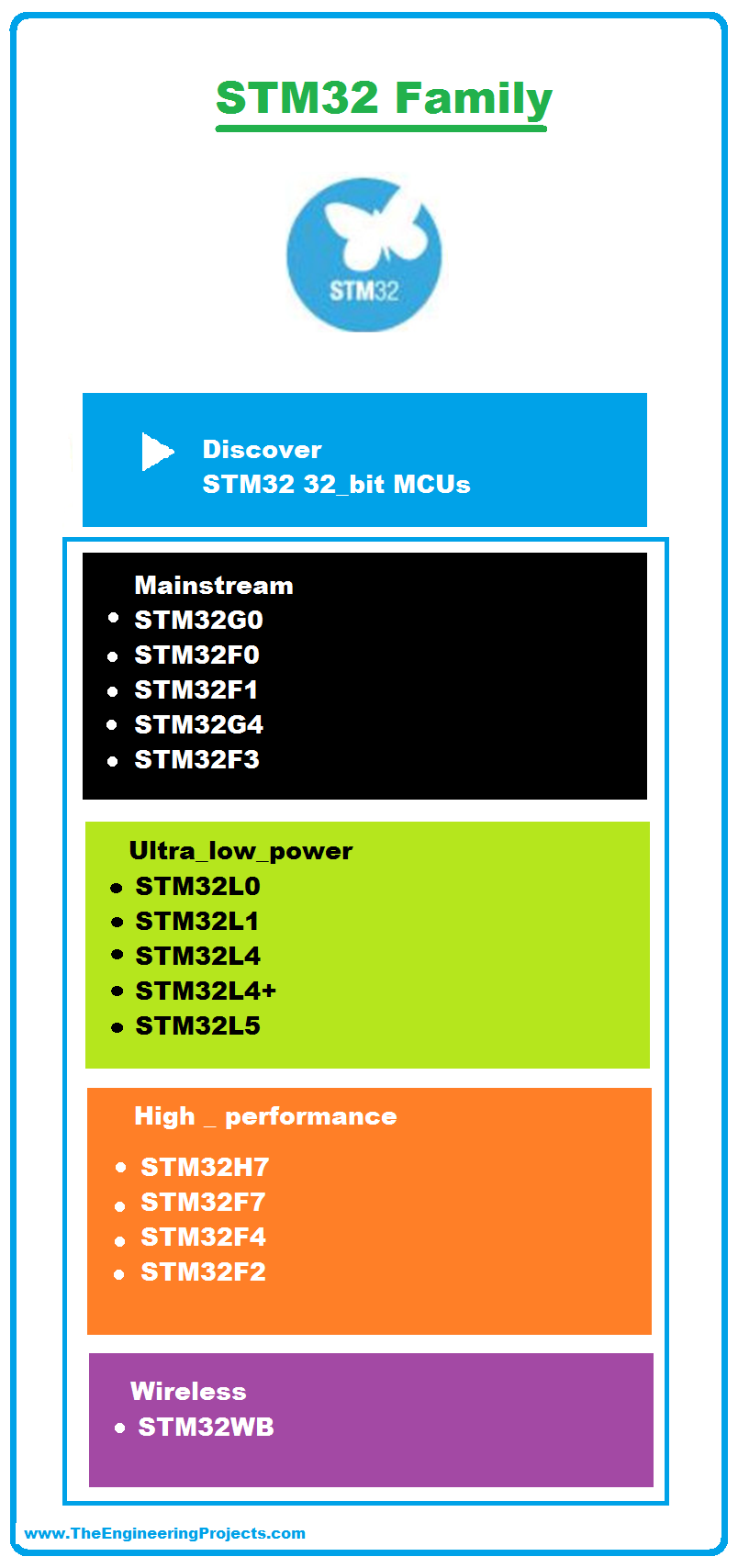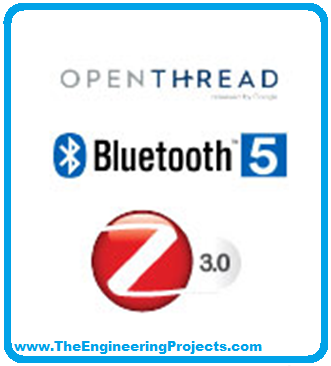
The term, "STM32" refers to a family of 32-bit microcontroller integrated circuits based on the ARM® Cortex®M processor. The architecture of these CPUs (Central Processing Unit) is ARM (Advanced Risk Machine) which is a particular family of Reduced Instruction Set Computing (RISC). RISC architecture differs from Complex Instruction Set Computing (CISC) for its simplicity that allows you to create processors capable of executing instruction sets with shorter times. Why use STM32? The advantages are many, and now we will list a part of them:
- ST offers a wide portfolio of solutions depending on the developer's needs. We can find products that combine different advanced features while maintaining a high level of integration. In fact, we can choose products with high performance, real-time processing, digital signal processing, and low consumption.
- Thanks to the availability of different development tools and available support material, the development of a simple or complex project is quite simple and fast, reducing the time to market if you want to develop a product.
- Each microcontroller has an integrated processor core, static RAM, flash memory, debug interface, and various peripherals such as GPIO, ADC, DAC, Timer, SPI, UART-USART, I2C, etc.
- For every MCU, ST provides the STM32 Nucleo Board that helps anyone who wants to fastly build and test prototypes for new projects with any STM32 MCU. STM32 Nucleo boards share the same connectors and can be easily expanded with many specialized application hardware add-ons (Nucleo-64 includes ST Morpho and Arduino Uno Rev3 connectors, while Nucleo-32 includes Arduino Nano connectors). Another and not insignificant advantage is the cheap cost of these development boards.
In the next paragraph, it will be illustrated how the STM32 is divided to easily identify the one used for your purposes.
| Where To Buy? | ||||
|---|---|---|---|---|
| No. | Components | Distributor | Link To Buy | |
| 1 | STM32 Nucleo | Amazon | Buy Now | |
STM32 Family
- To date, the STM32 family has 16 series of microcontrollers divided into four groups in order to cover all the needs of developers.
- The four groups are Mainstream, Ultra-Low-Power, High-Performance Wireless.

STM32 Mainstream
The STM32 Mainstream has been designed to offer solutions for a wide range of applications where costs, time to market, reliability, and availability are fundamental requirements. They are widely used in real-time control signal processing applications.
There are 5 series in this group:
- STM32F1 are microcontrollers based on the ARM Cortex-M3 core. It was launched in 2007 and evolved over time in terms of maximum clock rate, memory depth, and peripherals. In fact, the maximum clock rate has gone from 24 MHz to 72 MHz, static RAM up to 96 kB, and Flash up to 1024 kB. It also supports Thumb-1 and Thumb-2 instruction sets.
- STM32F0 are microcontrollers based on the ARM Cortex-M0 core. It was launched in 2012. The maximum clock rate is 48 MHz and includes the SysTick timer. Static RAM up to 32 kB, and Flash up to 256 kB. It also supports Thumb-1 and Thumb-2 instruction sets.
- STM32F3 are microcontrollers based on the ARM Cortex-M0 core. It was launched in 2012. The maximum clock rate is 72 MHz and includes the SysTick timer. Static RAM up to 40 kB, and Flash up to 256 kB. It also supports Thumb-1, Thumb-2, Saturated, DSP, FPU instruction sets.
- STM32G0 are microcontrollers based on the Cortex-M0/M0+ core. It was launched in 2018. The maximum clock rate is 64 MHz. Static RAM up to 128 kB, and Flash up to 512 kB. It also supports Thumb-1 and Thumb-2 instruction sets. Compared to the older F0 series, it presents improvements in terms of efficiency and performance.
- STM32G4 are microcontrollers based on the Cortex-M4F core. It was launched in 2019. The maximum clock rate is 170 MHz. Static RAM up to 128 kB, and Flash up to 512 kB. Thumb-1, Thumb-2, Saturated, DSP, FPU instruction sets. Compared to the older F3/F4 series, it presents improvements in terms of efficiency and performance and higher performance compared to the L4 series.
STM32 Ultra-Low-Power
The STM32 Ultra-Low-Power has been designed to meet the need to develop devices with low energy consumption (such as portable and wearable devices) but maintaining a good compromise with performance. There are 6 series in this group:
- STM32L0 are microcontrollers based on the ARM Cortex-M0+ core. It was launched in 2014. The maximum clock is 32 MHz, static RAM is of 8 kB, and Flash is up to 64 kB. It also supports Thumb-1 and Thumb-2 instruction sets.
- STM32L1 are microcontrollers based on the ARM Cortex-M3 core. It was launched in 2010. The maximum clock rate is 32 MHz, static RAM up to 80 kB, and Flash up to 512 kB. It also supports Thumb-1 and Thumb-2 instruction sets.
- STM32L4 are microcontrollers based on the ARM Cortex-M4 core. It was launched in 2015. The maximum clock rate is 80 MHz, static RAM is of 64 kB, and Flash is of 1024 kB. It also supports Thumb-1 and Thumb-2, Saturated, DSP, FPU instruction sets.
- STM32L4+ are microcontrollers based on the ARM Cortex-M4 core. It was launched in 2016. The maximum clock rate is 120 MHz, static SRAM up to 640 kB, and Flash up to 2048 kB. It also supports Thumb-1 and Thumb-2, Saturated, DSP, FPU instruction sets. It has been enriched with advanced peripherals such as a TFT-LCD controller, Camera interface, etc.
- STM32L5 are microcontrollers based on the ARM Cortex-M33F core. It was launched in 2018. The maximum clock rate is 110 MHz, static SRAM up to 640 kB, and Flash up to 2048 kB. It also supports Thumb-1 and Thumb-2, Saturated, DSP, FPU instruction sets.
- STM32U5 is the last ultra-low-power series launched (in 2021). It is an evolution of the L series and is based on the ARM Cortex-M33F core. the new 40 nm silicon technology allows to further reduce energy consumption, it also includes advanced cyber security features and graphics accelerators. The maximum clock rate is 160 MHz, static SRAM up to 640 kB, and Flash up to 2048 kB. It also supports Thumb-1 and Thumb-2, Saturated, DSP, FPU instruction sets.
STM32 High-Performance
The STM32 High-Performance has been designed for data processing and data transfer. It also has a high level of memory integration. There are 5 series in this group:
- STM32H7 are microcontrollers based on the ARM Cortex-M7F core. It was launched in 2017. The maximum clock is 480 MHz, static RAM is up to 1.4 MB, and Flash is up to 128 kB. It includes Ethernet and some advanced features such as dual Octo-SPI, JPEG codec, etc. It supports Thumb-1 and Thumb-2, Saturated, DSP, FPU instruction sets.
- STM32F7 are microcontrollers based on the ARM Cortex-M7F core. It was launched in 2014. The maximum clock is 216 MHz, static RAM is up to 1.4 MB, and Flash is up to 128 kB. It is fully pin-compatible with F4-series. It supports Thumb-1 and Thumb-2, Saturated, DSP, FPU instruction sets.
- STM32F4 was the first series of microcontrollers based on the ARM Cortex-M4F core. It was launched in 2011. The maximum clock is up to 180 MHz. It is the first series to have DSP and FPU. It also has faster ADCs, full-duplex I2S and an improved real-time clock. It supports Thumb-1 and Thumb-2, Saturated, DSP, FPU instruction sets.
- STM32F2 are microcontrollers based on the ARM Cortex-M3 core. It was launched in 2010. The maximum clock is 120 MHz, static RAM is up to 128 kB, and Flash is up to 1024 kB. It is fully pin-compatible with the F2 series. It supports Thumb-1, Thumb-2 and Saturated instruction sets.
STM32 Wireless
With STM32 Wireless ST adds in the portfolio a platform for wireless connectivity to the portfolio. It has a broad spectrum of frequencies and is used in various industrial and consumer applications.
It has features compatible with multiple protocols which allows it to communicate with different devices in real-time. Now, only two series belong to this group:
- STM32WB provides Bluetooth®LE 5.2 and IEEE 802.15.4 communication protocols, Zigbee® and Thread, which can work simultaneously or individually.

- STM32WL is the first series that support LoRa® communication.

So, that was all for today. I hope you have enjoyed today's lecture. In the next lecture, I am going to focus on the Nucleo Development board, as we are going to use that in our upcoming tutorials. Thanks for reading. Take care !!! :)



